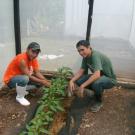This manual from the University of Florida IFAS Extension is in Spanish and contains information on horticultural production in protected environments including tunnels, greenhouses and net houses.
For the development of modern agriculture and competition, crop protection has been become a necessity. The consumers they demand products of excellent quality without damage by climatic agents, pests or diseases. In turn, farmers require high production (protected crops or semi-protected) to maintain the demands of markets, which implies the use of a series of technologies that are framed within the concept of protected agriculture.
Protected agriculture can be defined as in any closed structure, covered by transparent or semitransparent materials, which allows for artificial conditions of microclimate for the cultivation of plants and flowers. This specialized agricultural system is carried out with control of the edaphoclimatic environment altering its conditions (soil, temperature, solar radiation, wind, humidity, among others) which allows modify the natural environment in which they develop the crops, in order to achieve adequate plant growth, increase yields, and improve the quality of the product.
The facilities for the protection of crops can be very diverse among themselves by the characteristics and complexity of its structures, as well as by the greater or lesser ability to control environmental factors. A first classification of the various types of protection can be made by distinguishing between micro and macro-tunnels, greenhouses and net houses.

